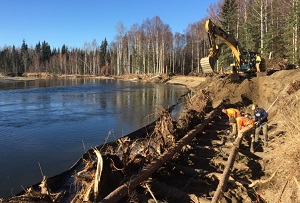Streambank Stabilization and Restoration
Best Practices

Chena River rootwad revetment installation
- Bank stabilization and/or restoration practices should follow bioengineering techniques to the extent practicable (root wads and willow bundles rather than sheet pile and rock). See the Streambank Revegetation and Protection guide for more information on these techniques.
- Maintaining a buffer of native vegetation (not lawn grass) from rivers, streams, and lakes can help improve water quality and fish habitat.
- Installation of in-water structures should avoid sensitive fish life stages such as spawning and/or migration periods whenever possible.
- Installation of silt curtains or cofferdams can be used to isolate the work area from the flowing water of a river, stream, or lake.
- Properly installed erosion and sediment control measures are important for preventing impacts to fish habitat during construction. Disturbed areas in a construction site should be stabilized and silt fencing or other measures installed to direct storm water away from fish bearing water bodies.
- When dewatering or isolating a work area, fish will likely need to be relocated. This requires an Aquatic Resource Permit from ADF&G. Contact your local Habitat Section office for more information on moving fish prior to in-water work.
